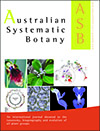Australian Systematic Botany
Volume 34
Number 6 2021
Psychotria sensu lato, Rubiaceae, has a high diversity of characters, and has been the subject of taxonomic and systematic controversies among authors. The anatomical development of fruits can be employed in a taxonomical study of the group. Our results showed that the fruit features can be useful in species identification, but the structural similarity of the fruits among all the analysed species suggests the maintenance of the genera Palicourea and Psychotria within tribe Psychotrieae.
Mushrooms are shy denizens of the bush, appearing singly or in small group after rain. We describe five new species and clarify three additional species, all from the economically and ecologically important genus Amanita. All are members of section Arenariae, which is currently known only from Australia.
The Australian genus Ptilotus (mulla mulla) is one of the most diverse genera in the amaranth family. Its closest relative occurs in Africa and Asia and is species-poor. Ptilotus was found to derive from an ancestor that arrived in Australia and diversified rapidly during an era of intense aridification events in Australia. Wet tropical and temperate Ptilotus species appear to be the product of more recent independent radiations from the drier regions, which are the origin of much of the current diversity.
Many macroalgal species are difficult to identify to the species level because of their morphological simplicity, phenotypic variation and frequent homoplasies. DNA barcode is a molecular technique that helps identify morphologically challenging specimens. We applied DNA barcoding techniques and species delimitation methods to study species diversity of the common intertidal brown algal genus Colpomenia in south-south-eastern Australia. We confirm the presence of three Colpomenia species in southern–south-eastern Australia, although there are four species described for this region. Future research including more widespread sampling is required to assess further Colpomenia species diversity across the entire country.
We reconstruct the evolution of phyllodinous and bipinnate adult foliage in Acacia, and examine the environmental correlates of these foliage types at a continental scale. Transformations between bipinnate and phyllodinous adult foliage exhibit asymmetry across the Acacia phylogeny, with transformations from bipinnate leaves to phyllodes occurring 30 times faster than the reverse. Tests for relationships between foliage type and 35 bioclimatic variables at the continental scale, corrected for phylogeny, identified two variables significantly correlated with foliage type, namely, moisture seasonality and radiation in the coldest quarter, with bipinnate species having lower species mean values of each.
 , Amanda A. O. do Carmo, Vanessa C. Harthman, Mariza B. Romagnolo and Luiz A. Souza
, Amanda A. O. do Carmo, Vanessa C. Harthman, Mariza B. Romagnolo and Luiz A. Souza




